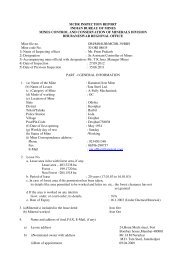Market Survey on Copper - Indian Bureau of Mines
Market Survey on Copper - Indian Bureau of Mines
Market Survey on Copper - Indian Bureau of Mines
Create successful ePaper yourself
Turn your PDF publications into a flip-book with our unique Google optimized e-Paper software.
c) Evaporati<strong>on</strong> <strong>of</strong> water from the copper free electrolyte and precipitati<strong>on</strong> <strong>of</strong><br />
nickel, ir<strong>on</strong> and cobalt as sulphates from the c<strong>on</strong>centrated soluti<strong>on</strong>. The nickel<br />
sulphate is purified and sold for electroplating and other uses.<br />
b) Hydrometallurgical Processes<br />
<strong>Copper</strong> is most <strong>of</strong>ten found in form <strong>of</strong> sulphide minerals which undergo<br />
pyrometallurgical operati<strong>on</strong> to produce crude copper (blister copper) metal. But<br />
the same is not true with copper oxide minerals. Oxide minerals when present<br />
in sufficient quantity in the ore deposits can be smelted in blast furnace<br />
ec<strong>on</strong>omically as has been the practice in the past. However, oxide ores are too<br />
low in copper to permit ec<strong>on</strong>omical hydrometallurgical extracti<strong>on</strong>. In additi<strong>on</strong>,<br />
many oxide minerals do not readily resp<strong>on</strong>d to froth flotati<strong>on</strong> and therefore<br />
need to be treated by n<strong>on</strong>-pyrometallurgical route, preferably,<br />
hydrometallurgical techniques. Hydrometallurgical extracti<strong>on</strong> comprises<br />
leaching, cementati<strong>on</strong>/solvent extracti<strong>on</strong> and electro winning.<br />
Hydrometallurgical techniques are applied mainly to oxidised copper<br />
ore, low grade oxide/sulphide mine wastes and roasted sulphide ores. Processes<br />
have been developed to extract copper hydrometallurgically from sulphide<br />
c<strong>on</strong>centrates too.<br />
Leaching Technology<br />
Although leaching is a chemical process, physical factors play an important<br />
role. The most important factor is the ingress <strong>of</strong> leach soluti<strong>on</strong> into the ore. There<br />
are three types <strong>of</strong> voids in rocks - fractures, cleavage planes and fine pores. In most<br />
copper bearing rocks, copper minerals are c<strong>on</strong>centrated in fractures and cleavage<br />
planes where soluti<strong>on</strong> can more readily come in c<strong>on</strong>tact with them than if they were<br />
disseminated through the entire rock.<br />
Diffusi<strong>on</strong> is an important acti<strong>on</strong> in leaching. As the soluti<strong>on</strong> penetrates the<br />
interior <strong>of</strong> the rock and dissolves copper minerals, a diffusi<strong>on</strong> pressure is created and<br />
soluble salts diffuse to a less c<strong>on</strong>centrated soluti<strong>on</strong> at the surface <strong>of</strong> the rock.<br />
The actual rate <strong>of</strong> dissoluti<strong>on</strong> depends up<strong>on</strong> the type <strong>of</strong> leaching and the<br />
c<strong>on</strong>tacting c<strong>on</strong>diti<strong>on</strong>s. Typical leaching cycles for oxidised ores are 5-12 hours for<br />
fine c<strong>on</strong>centrate with agitati<strong>on</strong> leaching, 5-10 days for crushed particles in vat<br />
leaching and 100-180 days in heap leaching. Factors favouring rapid leaching rates<br />
are high acid strength, elevated temperature (up to 60 o C), large c<strong>on</strong>tact area and good<br />
agitati<strong>on</strong>.<br />
<strong>Copper</strong> sulphide minerals dissolve mainly under extremely oxidising c<strong>on</strong>diti<strong>on</strong>s<br />
provided by high oxygen pressure.<br />
The best solvent for oxidised minerals is sulphuric acid. It is cheap and can be<br />
partly regenerated in leaching <strong>of</strong> sulphide/sulphite minerals. The best solvent for<br />
sulphide minerals is acidified ferric sulphate.<br />
In some cases, amm<strong>on</strong>ia and hydrochloric acid are used for nickel-copper<br />
sulphide ores/mattes. The leaching <strong>of</strong> sulphide ores with sulphuric acid as already<br />
42
















